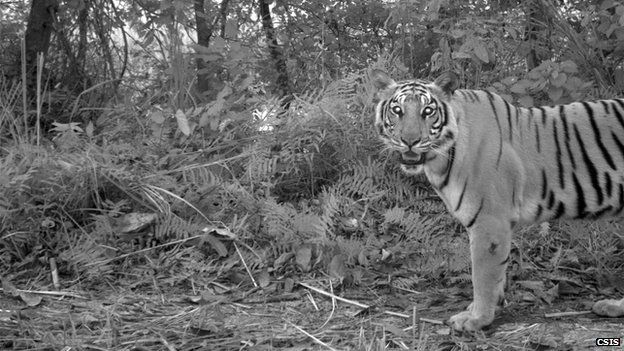Tigers 'take night shift' to dodge humans
- Published

Tigers in Nepal seem to be taking night shifts in order to avoid their human neighbours, a study has shown.
The big cats generally move around at all times of the day and night, to monitor territory, mate and hunt.
But the study of tigers in Chitwan National Park - where humans and tigers walk the same paths - showed a nocturnal shift in activity.
The research, by an international team, is published in Proceedings of the National Academy of Sciences journal.
The results challenge the conventional wisdom that tigers need lots of people-free space. This can lead to people being relocated, or their access to resources compromised to make way for tigers.
"It's a very fundamental conflict over resources," said co-author Neil Carter, from Michigan State University in East Lansing, US.
"Tigers need resources, people need the same resources. If we operate under the traditional wisdom that tigers only can survive with space dedicated only for them, there would always be conflict. If your priority is people, tigers lose out. If your priority is tigers, people lose out."
Chitwan, nestled in a Himalayan valley, is home to about 121 tigers. People live on the park's borders, but rely on the forests for wood and grasses, venturing in on roads and narrow footpaths.
Mr Carter spent two seasons setting motion-detecting camera traps for tigers, their prey and people who walk the roads and trails of Chitwan, both in and around the park.
His analysis of the thousands of images show that people and tigers are walking the same paths, albeit at different times of the day. The cameras documented a pronounced shift towards nocturnal activity in the tigers.
People generally avoid the forests at night, so dusk would seem to provide a signal for tigers to come out and play.
Mr Carter said that conditions for tigers in Chitwan were good, with high prey numbers, low levels of poaching, and forests that are re-generating outside the boundaries of the park.
But, he explained: "People of different stripes, including tourists and local residents, frequent the forests of Chitwan.
"Tigers need to use the same space as people if they are to have a viable long-term future. What we're learning in Chitwan is that tigers seem to be adapting to make it work."
Since the start of the 20th Century, the world's population of wild tigers has dropped by 97% from an estimated 100,000 to approximately 3,000 individuals. The world's remaining tigers are being pushed into small spaces, and being able to share that space with humans is a critical survival skill.
"There appears to be a middle ground where you might actually be able to protect the species at high densities and give people access to forest goods they need to live," said Mr Carter.
"If that's the case, then this can happen in other places, and the future of tigers is much brighter than it would be otherwise."
Co-author Jianguo "Jack" Liu, also from Michigan State University, commented: "We've found something very interesting is happening in Nepal that holds promise for both humans and nature to thrive."
- Published24 July 2012
- Published9 November 2010
- Published22 December 2010